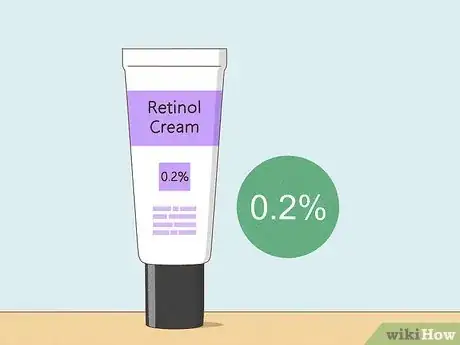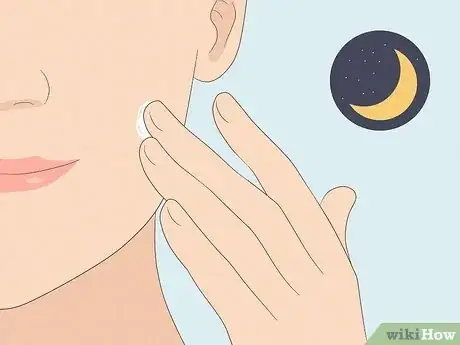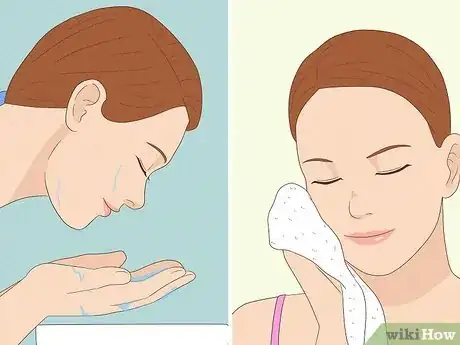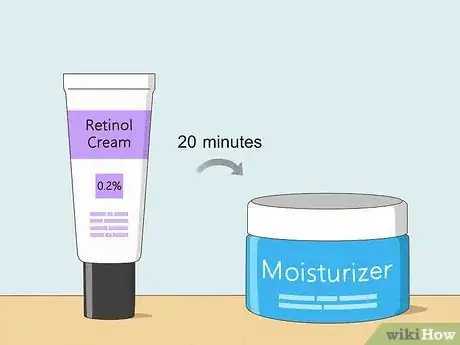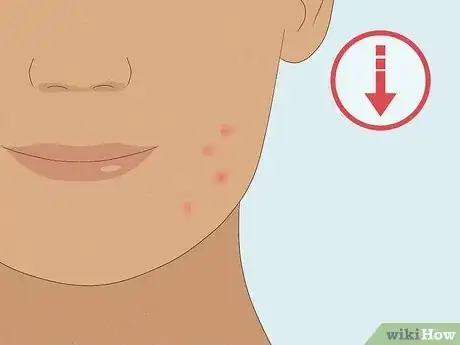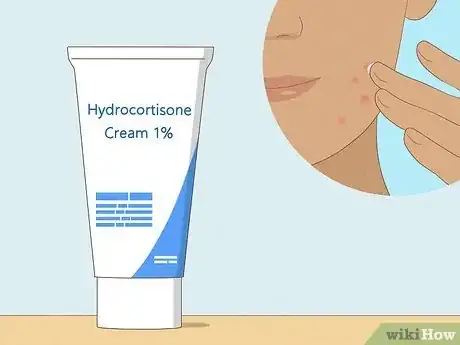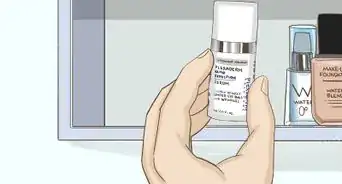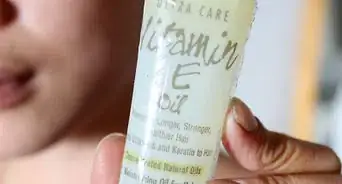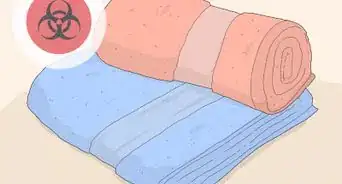This article was co-authored by Kaveri Karhade, MD and by wikiHow staff writer, Hunter Rising. Dr. Kaveri Karhade is a board certified Laser, Medical, and Cosmetic Dermatologist in the San Francisco Bay Area. Her areas of expertise are acne and hair loss. She has advanced training in injectables, lasers, surgery, and other cosmetic treatments, and has published extensive research in medical journals. She holds a BS from Michigan State University and a Doctor of Medicine (MD) from the University of Michigan Medical School. She completed her internship in Internal Medicine at New York University School of Medicine and her Residency in Dermatology at Brown University School of Medicine. Dr. Karhade is a fellow of the American Academy of Dermatology and a member of the American Society for Dermatologic Surgery.
There are 13 references cited in this article, which can be found at the bottom of the page.
This article has been viewed 110,447 times.
Trying to smooth out fine lines and wrinkles? Or do you want to get rid of acne or dark spots on your face? If you want clear, healthy skin and anti-aging effects all in one, then retinol cream or serum is the perfect solution for you. This form of vitamin A helps refresh your skin to remove blemishes, but there are a few tricks to apply it properly and keep your skin safe. With our quick and easy-to-follow guide, you’ll easily be able to include retinol in your daily skincare routine!
Things You Should Know
- Apply retinol cream at night before you go to bed so it has the most time to absorb into your skin.
- Wash your face with gentle face wash and warm water. Let your skin dry for 30 minutes to prevent irritation from the retinol.
- Rub a pea-sized amount of retinol cream into clean, dry skin. Work the retinol in using gentle upward and outward strokes.
- Use retinol every 2–3 days, and increase the frequency if you don’t have redness or irritation. Wear SPF 30 sunscreen to keep your skin protected after using it.
Steps
Application
-
1Get 0.2% retinol cream to start at a low concentration. Retinol is pretty powerful, but higher concentrations can dry out your skin if you’re not used to it. Choose a retinol cream with the lowest concentration the first time you add it to your skincare routine so you’re less likely to cause unwanted irritation. As your skin gets used to using retinol, you can try a higher concentration instead.[1]
- Retinol creams are also available at prescription strength, but only use them if your dermatologist recommends them since they can cause more irritation.
-
2Apply retinol at night. Sunlight makes vitamin A in retinol less effective, so applying it before you go to bed helps you get the full effects of the cream. Since you don’t have to wash the retinol off after you put it on, you can let it absorb into your skin overnight while you’re sleeping.[2]
- Develop a regular skincare routine at night so you don’t forget to apply retinol.
Advertisement -
3Wash your face and wait 30 minutes for your skin to dry. Use a gentle facial soap and warm water to get rid of any dirt and oil so you have a clean face. Pat your face dry with a towel, and then let your skin completely air-dry.[3]
- Avoid using retinol when you have wet skin since it could cause more skin irritation.
- Treat under-eye wrinkles with eye cream instead since your skin there is more sensitive and retinol may irritate it.[4]
-
4Rub a pea-sized amount of retinol into your skin. Squeeze the retinol out onto your fingertip and dab it lightly over your forehead, cheeks, nose, and chin. After that, start working the retinol cream into your skin. Keep the cream away from te corners of your eyes and the corners of your mouth since it could build up and cause more irritation there.[5]
- Avoid using more retinol than you need to since you could make your skin feel irritated and red.
- You do not need to wash retinol off after you apply it.
-
5Follow up with a moisturizer after about 20 minutes. As soon as the retinol absorbs into your skin, take a fingertip-sized amount of moisturizer and rub it into your skin. Since vitamin A makes your skin feel dry, moisturizer will help keep it protected and hydrated while the retinol works its magic.[6]
-
6Use retinol every 2 or 3 days when you first add it to your routine. As the retinol absorbs into your skin, it helps promote collagen growth and cell turnover, so it can cause a little bit of peeling. Give yourself a few days to see how your skin reacts to the retinol, and wait until you don’t have any redness or irritation before you use it again.[7]
- If you have sensitive skin, wait a full week before you use retinol products again.
-
7Work up to daily use over the next few weeks. As your skin gets used to retinol, you won’t notice as much irritation or flaking on your skin. Rather than waiting every few days, try using retinol every other day and check how your skin reacts. If there are still no signs of irritation, you’re safe to use retinol every night.[8]
- It may take a few weeks or months for noticeable results from retinol. Just stay persistent and continue using it if it’s not causing any irritation. As long as you keep using retinol correctly, you can control acne and minimize your pores.[9]
- Continue using retinol even after you get rid of acne to help new breakouts from coming in.
Managing Side Effects
-
1Protect your skin from the sun during the day. Retinol makes your skin more sensitive to ultraviolet rays from the sun, so you’ll get sunburn a lot faster when you’re outside. Since you don’t want to damage your skin as new cells turn over, stay in the shade, apply SPF 30 sunscreen, wear long clothes, or put on a big, wide-brimmed hat to prevent sunburn.[10]
- If you have sensitive skin, use a sunscreen that has titanium dioxide or zinc oxide for even more protection.
- Even if you aren’t going outside, apply [lotion with added SPF] to keep your skin protected from future dark spots and sun damage.
-
2Cut back on using retinol if you have red or irritated skin. It’s completely normal for retinol to make your skin red and flake for the first couple of days as new skin cells come in. However, too much retinol can dry out your skin and make it feel raw to the touch. If you started using retinol more frequently, then reduce how often you use it during the week until your skin heals. If you’re still getting irritation, then you may need to use a lower concentration.[11]
- If you’re already using the lowest-concentration retinol you can find and you’re still getting irritation, stop using it as part of your skincare routine and contact a doctor or dermatologist to find alternative solutions.
-
3Try applying 1% hydrocortisone over irritated skin for instant relief. Take a bead-sized amount of hydrocortisone cream and gently rub it into your skin.[12] Use the hydrocortisone twice a day to help treat any itchy or red skin caused by the retinol.[13]
- Stop using hydrocortisone as soon as your skin heals since using it continuously can cause your skin to get thinner.
-
4Avoid using retinol with other acids or exfoliants to prevent redness. Stay away from using alpha or beta hydroxy acids, as well as salicylic and glycolic acids, as part of your skincare routine if you’re using retinol. Since retinol is already pretty powerful, exfoliating products like vitamin C, benzoyl peroxide, and scrubs will only make your skin more red or irritated before it has a chance to heal.[14]
- Avoid using retinol when you do a chemical peel since it will dry out your skin as it tries to heal.
Expert Q&A
-
QuestionWhat does Retinol do?
 Alicia RamosAlicia Ramos is a licensed aesthetician and the owner of Smoothe Denver in Denver, Colorado. She received her license at the School of Botanical & Medical Aesthetics, with training in lashes, dermaplaning, waxing, microdermabrasion, and chemical peels, and now provides skin care solutions to hundreds of clients.
Alicia RamosAlicia Ramos is a licensed aesthetician and the owner of Smoothe Denver in Denver, Colorado. She received her license at the School of Botanical & Medical Aesthetics, with training in lashes, dermaplaning, waxing, microdermabrasion, and chemical peels, and now provides skin care solutions to hundreds of clients.
Skincare Professional Typically, retinoids will smooth out your skin, reduce the appearance of wrinkles, and may even help to reduce sun spots or other pigmentation problems. They do this by encouraging the top layer of your skin to peel away, revealing younger, fresher skin underneath. This prompts your body to produce more new, healthy skin cells, and it actually increases the life of your collagen, which is the part of your skin that's known to make it look youthful and full.
Typically, retinoids will smooth out your skin, reduce the appearance of wrinkles, and may even help to reduce sun spots or other pigmentation problems. They do this by encouraging the top layer of your skin to peel away, revealing younger, fresher skin underneath. This prompts your body to produce more new, healthy skin cells, and it actually increases the life of your collagen, which is the part of your skin that's known to make it look youthful and full.
Warnings
- Avoid using topical retinol if you’re pregnant since high concentrations could be harmful to your baby.[15]⧼thumbs_response⧽
References
- ↑ https://www.vogue.in/beauty/content/right-application-method-for-retinol-best-retinol-products-to-buy
- ↑ https://www.aad.org/public/everyday-care/skin-care-secrets/anti-aging/retinoid-retinol
- ↑ https://www.aad.org/public/everyday-care/skin-care-secrets/face/treat-large-pores
- ↑ https://www.vogue.in/beauty/content/right-application-method-for-retinol-best-retinol-products-to-buy
- ↑ https://youtu.be/XhPndYGWEao?t=118
- ↑ Kaveri Karhade, MD. Board Certified Dermatologist. Expert Interview. 11 January 2021.
- ↑ https://www.aad.org/news/prevent-premature-skin-aging
- ↑ https://www.glamour.com/story/retinol-for-acne
- ↑ Kaveri Karhade, MD. Board Certified Dermatologist. Expert Interview. 11 January 2021.
- ↑ https://www.aad.org/public/everyday-care/skin-care-secrets/anti-aging/retinoid-retinol
- ↑ https://youtu.be/XhPndYGWEao?t=237
- ↑ https://www.ncbi.nlm.nih.gov/pmc/articles/PMC2699641/
- ↑ https://newsnetwork.mayoclinic.org/discussion/steroid-creams-can-help-with-skin-inflammation-but-are-not-a-cure/
- ↑ https://www.vogue.in/beauty/content/right-application-method-for-retinol-best-retinol-products-to-buy
- ↑ https://www.ncbi.nlm.nih.gov/pmc/articles/PMC2699641/
About This Article
To use retinol cream, apply it to your face before bed, since your skin will absorb it better at night. Before you apply it, wash your face with a gentle soap and wait 20 minutes for your skin to dry. Once your face is dry, squeeze a pea-sized amount of retinol onto your finger. Then, apply about half of it to your forehead and the rest to your cheeks and chin. Rub the cream into your skin using circular motions until you can't see it anymore. If you moisturize your face, wait another 20 minutes after the retinol before applying your moisturizer, so your skin can absorb it properly. When you first start, wait 3-4 days before you use retinol cream again, to avoid your face drying out. Then, after a couple of weeks, use it 3 times a week for about 3 weeks. Slowly increase your usage for 6 months until you’re using it every day, since your skin can gradually get used to the cream. For more tips, including how to recognize and deal with side effects of retinol cream, read on!
